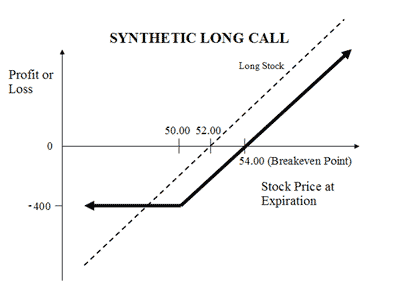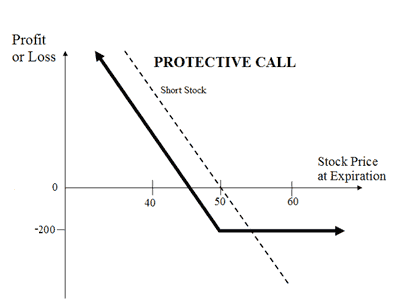 Zerodha (Trading Account)
Zerodha (Trading Account)
FREE Equity Delivery and MF
Flat ₹20/trade Intra-day/F&O
 Zerodha (Trading Account)
Zerodha (Trading Account)
FREE Equity Delivery and MF
Flat ₹20/trade Intra-day/F&O

|
|
Compare Synthetic Call and Protective Call (Synthetic Long Put) options trading strategies. Find similarities and differences between Synthetic Call and Protective Call (Synthetic Long Put) strategies. Find the best options trading strategy for your trading needs.
| Synthetic Call | Protective Call (Synthetic Long Put) | |
|---|---|---|
 |
 |
|
| About Strategy | A Synthetic Call strategy is used by traders who are currently holding the underlying asset and are Bullish on it for the long term. But he is also worried about the downside risks in near future. This strategy offers unlimited reward potential with limited risk. The strategy is used by buying PUT OPTION of the underlying you are holding for long. If the price of the underlying rises then you make profits on holdings. If it falls then your loss will be limited to the premium paid for PUT OPTION. | The Protective Call strategy is a hedging strategy. In this strategy, a trader shorts position in the underlying asset (sell shares or sell futures) and buys an ATM Call Option to cover against the rise in the price of the underlying. This strategy is opposite of the Synthetic Call strategy. It is used when the trader is bearish on the underlying asset and would like to protect 'rise in the price' of the underlying asset. The risk is limited in the strategy while the rewards are unlimited. How to use a Protective Call trading strategy? The usual Protective Call Strategy looks like as below for State Bank of India (SBI) Shares which are currently traded at Rs 275 (SBI Spot Price): Protective Call Orders - SBI Stock Orde... Read More |
| Market View | Bullish | Bearish |
| Strategy Level | Beginners | Beginners |
| Options Type | Call + Underlying | Call + Underlying |
| Number of Positions | 2 | 2 |
| Risk Profile | Limited | Limited |
| Reward Profile | Unlimited | Unlimited |
| Breakeven Point | Underlying Price + Put Premium | Underlying Price - Call Premium |
| Synthetic Call | Protective Call (Synthetic Long Put) | |
|---|---|---|
| When to use? | A Synthetic Call option strategy is when a trader is Bullish on long term holdings but is also concerned with the associated downside risk. |
The Protective Call option strategy is used when you are bearish in market view and want to short shares to benefit from it. The strategy minimizes your risk in the event of prime movements going against your expectations. |
| Market View | Bullish |
Bearish When you are bearish on the underlying but want to protect the upside. |
| Action |
The strategy is used by buying PUT OPTION of the underlying you're holding for long. If the price of the underlying rises then you make profits on holdings. If it falls then your loss will be limited to the premium paid for PUT OPTION. |
|
| Breakeven Point | Underlying Price + Put Premium |
Underlying Price - Call Premium When the price of the underlying is equal to the total of the sale price of the underlying and premium paid. |
| Synthetic Call | Protective Call (Synthetic Long Put) | |
|---|---|---|
| Risks | Limited Maximum loss happens when price of the underlying moves above strike price of Put. Max Loss = Premium Paid |
Limited The maximum loss is limited to the premium paid for buying the Call option. It occurs when the price of the underlying is less than the strike price of Call Option. Maximum Loss = Call Strike Price - Sale Price of Underlying + Premium Paid |
| Rewards | Unlimited Maximum profit is realized when price of underlying moves above purchase price of underlying plus premium paid for Put Option. Profit = (Current Price of Underlying - Purchase Price of Underlying) - Premium Paid
|
Unlimited The maximum profit is unlimited in this strategy. The profit is dependent on the sale price of the underlying. Profit = Sale Price of Underlying - Price of Underlying - Premium Paid |
| Maximum Profit Scenario | Underlying goes up |
Underlying goes down and Option not exercised |
| Maximum Loss Scenario | Underlying goes down and option exercised |
Underlying goes down and Option exercised |
| Synthetic Call | Protective Call (Synthetic Long Put) | |
|---|---|---|
| Advantages | Provides protection to your long term holdings. |
Minimizes the risk when entering into a short position while keeping the profit potential limited. |
| Disadvantage | You can incur losses if underlying goes down and the option is exercised. |
Premium paid for Call Option may eat into your profits. |
| Simillar Strategies | Married Put | Long Put |


FREE Intraday Trading (Eq, F&O)
Flat ₹20 Per Trade in F&O
|
|
I had a positive experience with ( Fla )_ ( shrec )_ ( la im ) at gm_-ail DOT C-O-M or. ( Fla )_ ( shrec )_ ( la im ) at (o u t)~(lo ok). DOT c-0-m
It’s always helpful to have reliable resources to r_ecov_er funds after being scammed